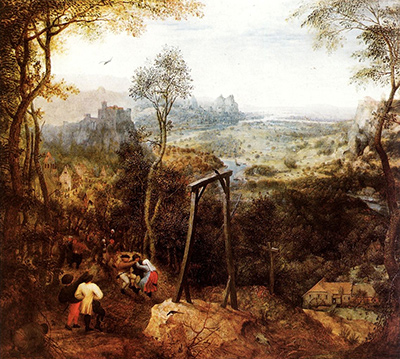Magpie on the Gallows was painted in 1568 as an oil on wood by Bruegel before his death in 1569. He left the painting to his wife.
On initial inspection, this appears to be a pleasant scene, two observers stopping in a clearing to look at the view of the river and valley in the distance.
However, placed in the centre of the image is a Magpie perched upon a gallows. A group of 3 peasants are dancing nearby.
A second magpie sits upon a tree stump and most strangely, in the bottom left corner, a figure is squatting and appears to be defecating.
Bruegel left no information about his paintings but they appear to have many hidden meanings which art historians have tried to unravel.
Magpie on the Gallows was painted a year after the Spanish King Phillip II had sent the third Duke of Alva to the Netherlands to suppress the Dutch Revolt.
Many feel that this image was Bruegel's political comment on the situation. Several art historians have noted that Bruegel appears to have indirectly portrayed a number of proverbs from the Netherlands.
Bruegel had done this previously in his painting "Netherlandish Proverbs".
The magpies are thought to represent the foolish gossip that can lead to death on the gallows.
The defecating man and the dancing trio appear to suggest "dancing or shitting on the gallows", thus mocking the state.
It is interesting that the onlooker in the scene is pointing, a technique which draws the viewer's eye but it is not clear what he is pointing to.
The gallows themselves are fascinating, although the feet are painted almost inline, the top of the gallows is twisted and facing into the distance.
Magpie on the Gallows is a wonderful piece of art which will continue to please and yet challenge the viewer with its many mysterious and hidden messages.




